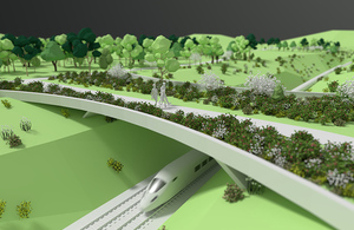Ministers have announced more than £8m for new woodlands and road improvements for Phase 2a of the new high speed rail line.
HS2 Ltd has also announced plans to plant seven million new trees alongside Phase 1.
The Department for Transport (DfT) announced £6.5m for local authorities on the Birmingham to Crewe route through the HS2 Road Safety Fund, ‘to deliver improvements for pedestrians, cyclists and drivers’. The cash adds to the £30m for road safety improvements on the Phase 1 route announced last year.
HS2 Minister Nusrat Ghani also announced £2m for the HS2 Woodland Fund, to help landowners along the route between Birmingham and Crewe (Phase 2a) plant new trees native to the area.

Animation depicting a 'green bridge' along the HS2 route.
She said: ‘As we deliver the new high speed railway our country needs, it is imperative we set a new standard for protecting and enhancing our diverse woodlands and wildlife.’
Although the DfT described the £8.5m funding as 'extra', it confirmed to Transport Network that the case comes from HS2's existing budgets, which total 56bn.
Joe Rukin, Stop HS2 Campaign Manager said: ‘With 98 irreplaceable ancient woodlands under threat from HS2, this announcement is cynical corporate greenwashing at its worst, in the hope it will distract people from the fact H22 is billions of pounds over budget and spiralling out of control.’
The Government-owned firm claimed that the environmental works would be largest ever undertaken by an infrastructure project in the UK and would ‘set new standards for how Britain and the rest of Europe builds the next generation of major infrastructure projects’.
HS2 Ltd chief executive Mark Thurston said: ‘Alongside improving connectivity, boosting the economy and unlocking new jobs and opportunities, I’m determined to ensure that HS2 also works for the environment and local communities.’
The green corridor along the 216km Phase 1 route from London to the West Midlands, will include:
- Seven million new trees and shrubs, including over 40 native species, specific to each location. The new native woodlands will cover over nine square kilometres of land.
- Over 33 square kilometres of new and existing wildlife habitat – equating to an area the size of 4,600 football pitches. That’s an increase of around 30% compared to what’s there now.
- Tailor-made homes for wildlife, ranging from bat houses to 226 new ponds for great crested newts and other amphibians.
- Earthworks and landscaping which will re-use around 90% of the material excavated during construction.
- The potential to support community projects and develop amenity spaces such as access routes, public parks, open spaces and nature reserves.
Register now for full access
Register just once to get unrestricted, real-time coverage of the issues and challenges facing UK transport and highways engineers.
Full website content includes the latest news, exclusive commentary from leading industry figures and detailed topical analysis of the highways, transportation, environment and place-shaping sectors.
Use the link below to register your details for full, free access.
Already a registered? Login